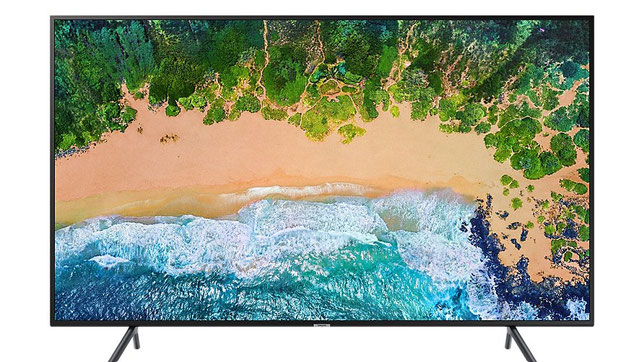Review and compare Samsung TV 2018 NU7470 and NU7100 Series

In a review of the Samsung NU7100 and NU7470 TVs, let's look at what we can expect from these models, and what not. This model in the budget price segment. And knowing what a wide choice Samsung TV manufacturer offers us, here also the models using QD technology of the proudly named QLED TVs and various series of TV sets NU and N-series, I would put it more precisely, consider the models of the lower row of medium- budgetary price sector.
The TV screen is made in a classical style and has a flat surface. For fans of curved panels the manufacturer in 2018 produces UltraHD TV Samsung series NU7300; NU7500, which in addition to the form of the screen is almost nothing, according to the characteristics, do not differ from their counterparts in the classical performance. NU7300, this is an analogue of model NU7100, and model NU7500 is an analogue of NU7470, the difference consists only in the form of the plane of the screen. It is worth mentioning that Samsung in 2018 "increased status", for its younger models of TVs and made the rank of the seventh series of models, which in 2017 attributed to the sixth series. This is done with only one goal, to attract as many buyers as possible to their side.

Main features and differences of models NU7470 and NU7100
The main differences between the NU7100 and NU7470 are the support for the older Bluetooth model, which is missing from the NU7100, respectively, and the remote control in the set for each TV has differences, the NU7100 comes with a conventional keypad without Bluetooth and voice search, while the NU7470 has a modern Smart -remote controller:

A more modern NU7470 with Bluetooth support and voice search support is much more convenient when using Smart functions. Also, the TV model NU7470 will be a more interesting choice for those wishing to have a wireless keyboard and mouse connection, as well as the ability to connect acoustics to Bluetooth, while the younger model (NU7100) has options for connecting speakers to HDMI (ARC) and optics.
The difference between these models of TVs is also in the fact that the NU7470 will have a slightly wider color range and brightness. But, since out of the box both TVs have decent color accuracy, without calibration, both TVs in the Cinema mode have practically no difference, it is minimal.
In comparison with the models of the sixth series of the previous year, the 2018 models look brighter, but the peak brightness, as well as on all budget models, is mediocre, especially said when reproducing HDR-formatted content on TVs.
Technical specifications of Samsung 2018 TV series NU7470 and 7100
As in 2017, the manufacturer sets different types of matrices for the same TV model, both VA and IPS (in Samsung PLS), with a real frequency of the matrix of 60 Hz, basically this item refers to
televisions in 43 and 49 inches. Both models have the type of Edge backlighting, the LEDs are arranged in one row on the bottom edge of the TV. On board both one and the other TVs there are three
HDMI inputs, all have full bandwidth, a third HDMI ARC, two USB 2.0 ports, a digital optical audio output, component and composite inputs, RS-232; Ethernet, digital audio output.
Like other Samsung 2018 TVs, the NU7100 and NU7470 do not play the DTS audio format, as the manufacturer stated: - "DTS Audio codec is no longer supported on all TV devices of 2018". Black
semi-glossy screen copes well with ambient lighting thanks to a fully effective anti-reflective filter. The quality of the assembly of TVs is good.
Smart features / Smart TV. on the NU7100 with the same interface as on the NU7470, with the exception of the Bixby voice assistant. The interface is easy to navigate and works well, although
there are some problems with the delay when accessing the interface from applications. Like all Samsung TVs, there is advertising, it can not be deleted, or abandoned. Remote application is very
simple, much easier than remote applications from other TV manufacturers. There are several pre-installed applications, the same as on most other brands of TVs (Amazon Video, Netflix, YouTube,
etc.).
Both TVs have good pixel response, low in-compile in gaming and PC modes, so they will be interesting to those users who use TVs as a monitor.
Televisions come in sizes of diagonals: 43, 49, 50, 55, 65 and 75 inches.